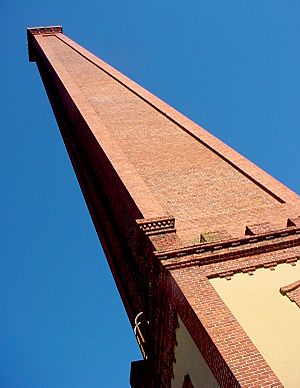Confederate Powderworks facts for kids
The Confederate Powderworks, also known as the Augusta Powder Works, was a very important factory that made gunpowder during the American Civil War. It's special because it's one of the few big buildings built by the Confederate States of America that wasn't destroyed by the Union army.
Colonel George Washington Rains chose a safe spot for the factory. It was located in Augusta, Georgia, between the Augusta Canal and the Savannah River. This location was great because it had good ways to transport materials by train and water. During the war, this factory produced almost 3 million pounds of gunpowder.
Contents
Building a Powder Factory
George Rains' Big Job
George Washington Rains was a smart guy who went to West Point, a famous military school. He even taught chemistry there! He fought bravely in the Mexican War. When the Civil War started, he chose to support his home state of North Carolina.
Jefferson Davis, who was the president of the Confederacy, gave Rains a huge task. He told Rains to build a factory to make gunpowder for the whole Confederacy. Rains had complete freedom to do it his way.
How the Factory Was Built
Construction of the powder works started in September 1861. They even bought a powerful steam engine from a flour mill. Amazingly, the factory was making gunpowder in just seven months, by 1862!
Rains got his ideas from a British officer's booklet. This booklet described a gunpowder factory in England called Waltham Abbey. He even found someone who had worked there to help him.
A Smart Design
Gunpowder factories, also called powder mills, were built in a special way. Their buildings were spread out and designed to survive explosions. Raw materials would start at one end of the factory. The finished gunpowder would end up about a mile and a half away at the other end.
The largest building was for refining saltpeter, a key ingredient. It was designed in a fancy Gothic style. It looked like a smaller version of the British Houses of Parliament.
Making Lots of Gunpowder
The Confederate Powderworks was the second largest gunpowder factory in the world at that time. It could make 3.5 tons of gunpowder every single day! Before it closed in 1865, it produced over 2.75 million pounds of high-quality gunpowder. This was most of the gunpowder used by the Confederacy.
What's Left Today
The Last Standing Chimney
After the war ended, most of the huge factory was taken apart. But in 1872, George Rains asked for one part to be saved. He wanted the tall, obelisk-shaped chimney to remain. He had designed it to be a "monument to the Confederacy" even if the factory was gone.
In 1879, the city of Augusta gave the chimney to the Confederate Survivors Association. They were asked to protect it as a memorial. They fixed up its base and added a marble tablet. This tablet honored the fallen nation and the soldiers who died in the war.
A Landmark in Augusta
Today, the 150-foot tall chimney still stands proudly by the Augusta Canal. It's one of the most famous sights in the Augusta skyline. You can find it at the Sibley Mill at 1717 Goodrich Street.
The Sibley cotton mill was built on the factory's old site between 1880 and 1882. It used bricks from the taken-apart powder works. This mill became one of the biggest and most successful cotton mills in the area. It made denim fabric until 2006. Even now, the mill's water-powered turbines still make electricity that is sold to Georgia Power.
Restoring History
The chimney is the only part left of the original powder works. A group called the B/G E. Porter Alexander Camp #158, Sons of Confederate Veterans, worked for eight years to raise money. They collected $192,000 to restore the chimney and its historical marker. The restoration work started in November 2009 and finished in March 2010. A special ceremony to rededicate it was held in October 2010.


